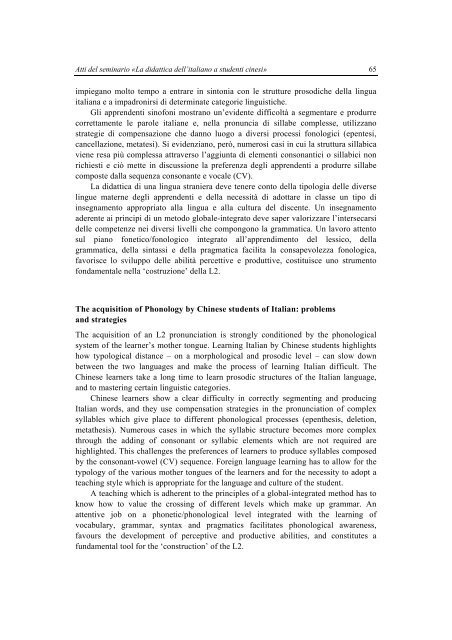La didattica dell'italiano a studenti cinesi e il progetto Marco Polo ...
La didattica dell'italiano a studenti cinesi e il progetto Marco Polo ...
La didattica dell'italiano a studenti cinesi e il progetto Marco Polo ...
Create successful ePaper yourself
Turn your PDF publications into a flip-book with our unique Google optimized e-Paper software.
Atti del seminario «<strong>La</strong> <strong>didattica</strong> dell’italiano a <strong>studenti</strong> <strong>cinesi</strong>» 65<br />
impiegano molto tempo a entrare in sintonia con le strutture prosodiche della lingua<br />
italiana e a impadronirsi di determinate categorie linguistiche.<br />
Gli apprendenti sinofoni mostrano un’evidente difficoltà a segmentare e produrre<br />
correttamente le parole italiane e, nella pronuncia di s<strong>il</strong>labe complesse, ut<strong>il</strong>izzano<br />
strategie di compensazione che danno luogo a diversi processi fonologici (epentesi,<br />
cancellazione, metatesi). Si evidenziano, però, numerosi casi in cui la struttura s<strong>il</strong>labica<br />
viene resa più complessa attraverso l’aggiunta di elementi consonantici o s<strong>il</strong>labici non<br />
richiesti e ciò mette in discussione la preferenza degli apprendenti a produrre s<strong>il</strong>labe<br />
composte dalla sequenza consonante e vocale (CV).<br />
<strong>La</strong> <strong>didattica</strong> di una lingua straniera deve tenere conto della tipologia delle diverse<br />
lingue materne degli apprendenti e della necessità di adottare in classe un tipo di<br />
insegnamento appropriato alla lingua e alla cultura del discente. Un insegnamento<br />
aderente ai principi di un metodo globale-integrato deve saper valorizzare l’intersecarsi<br />
delle competenze nei diversi livelli che compongono la grammatica. Un lavoro attento<br />
sul piano fonetico/fonologico integrato all’apprendimento del lessico, della<br />
grammatica, della sintassi e della pragmatica fac<strong>il</strong>ita la consapevolezza fonologica,<br />
favorisce lo sv<strong>il</strong>uppo delle ab<strong>il</strong>ità percettive e produttive, costituisce uno strumento<br />
fondamentale nella ‘costruzione’ della L2.<br />
The acquisition of Phonology by Chinese students of Italian: problems<br />
and strategies<br />
The acquisition of an L2 pronunciation is strongly conditioned by the phonological<br />
system of the learner’s mother tongue. Learning Italian by Chinese students highlights<br />
how typological distance – on a morphological and prosodic level – can slow down<br />
between the two languages and make the process of learning Italian difficult. The<br />
Chinese learners take a long time to learn prosodic structures of the Italian language,<br />
and to mastering certain linguistic categories.<br />
Chinese learners show a clear difficulty in correctly segmenting and producing<br />
Italian words, and they use compensation strategies in the pronunciation of complex<br />
syllables which give place to different phonological processes (epenthesis, deletion,<br />
metathesis). Numerous cases in which the syllabic structure becomes more complex<br />
through the adding of consonant or syllabic elements which are not required are<br />
highlighted. This challenges the preferences of learners to produce syllables composed<br />
by the consonant-vowel (CV) sequence. Foreign language learning has to allow for the<br />
typology of the various mother tongues of the learners and for the necessity to adopt a<br />
teaching style which is appropriate for the language and culture of the student.<br />
A teaching which is adherent to the principles of a global-integrated method has to<br />
know how to value the crossing of different levels which make up grammar. An<br />
attentive job on a phonetic/phonological level integrated with the learning of<br />
vocabulary, grammar, syntax and pragmatics fac<strong>il</strong>itates phonological awareness,<br />
favours the development of perceptive and productive ab<strong>il</strong>ities, and constitutes a<br />
fundamental tool for the ‘construction’ of the L2.

















